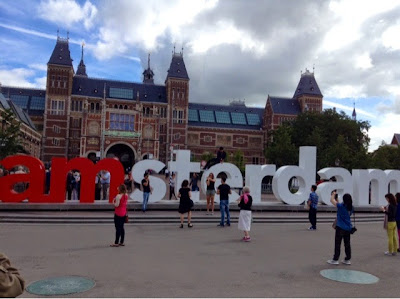
Long Weekend in Taupō
Easter Weekend rolled around early this year, just a few weeks after my birthday trip to Tauranga. I wasn’t expecting to be planning and taking so many trips not long after arriving in New Zealand! But I wanted to take advantage of having the public holidays off of work. So, with 4 whole days at my disposal, I decided on a long weekend in Taupō. It’s about a 4-hour drive from Wellington, which is far but manageable, so I drove up with the car I got from my brother. I broke up the journey though, driving halfway on Thursday night and staying in Ohakune that night. This put me on the doorstep of Tongariro National Park for some hiking, followed by a weekend exploring the geothermal sites and spas around Taupō and Rotorua.

Day One – Tongariro National Park
Mangawhero Falls
Tongariro was New Zealand’s first national park, and like the UK (unlike Canada and the USA), national parks are free to visit. New Zealand sits on the Pacific Ring of Fire, straddling a fault line, which creates volcanic activity around the Taupō area in particular. Tongariro National Park is home to no less than 3 volcanoes, which are technically still active. Mount Tongariro is actually the smallest; Ruapehu is the largest active volcano in the entire country; and Ngauruhoe is better known as Mount Doom, serving as its model in Lord of the Rings.
After my overnight in Ohakune, I started my day with a different Lord of the Rings filming location. Mangawhero Falls is on the south side of the park, and just a 20-minute drive from Ohakune. It was used as the Forbidden Pool in The Two Towers, where Gollum is fishing and gets caught by Faramir. After pulling into the lay-by at the side of the road, it’s only a 5-minute walk on the trail to see the falls. A small stream gurgles over its rocky bed then tumbles down a sharp drop. You can’t get to the base of the falls, but the trail leads to a good viewpoint further around the cliff side. The plunge pool is just visible between the trees and to the other side, I was greeted with wide views of the forest-clad hills.
The falls are pretty enough, but quite small. Considering how far they are from the park’s main attractions, I don’t think I would have bothered coming to them had I not been in Ohakune the night before. After I’d finished admiring them, I drove almost an hour around the western border of the park, heading for the visitor centre.
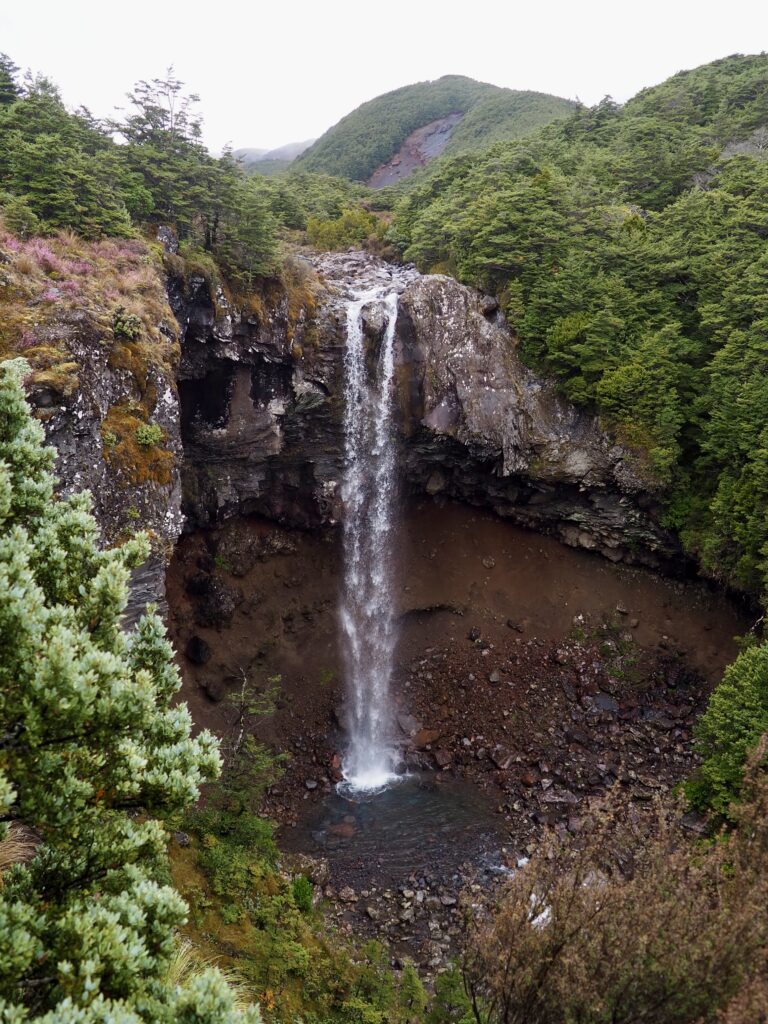

Tawhai Falls
So, Tawhai Falls is also known as Gollum’s pool and was apparently used for the same scene as Mangwhero Falls. Tawhai seems to be the better-known, but that could be because of it’s in a more-frequented area of the national park. I think there must have been some CGI magic going on to merge them perhaps! Tawhai is just off the main road as you drive into Tongariro National Park, so it’s an easy stop en-route, as long as you can get parked as there’s limited spaces.
I nabbed a free parking spot and crossed the road to the trailhead. It takes about 20 minutes or so to reach the falls and the trail is mostly downhill. Which does mean quite a few stairs to come back up again after! It had started to rain just as I arrived, but luckily I had waterproofs with me. The first part of the trail is quite exposed, but then I got some shelter beneath the tree cover as I approached the river. There are two viewpoints for the falls, one looking down from above and another further along the river looking back at it. It’s not a high waterfall, but the rapids in the river below it make for a scenic view. I could certainly picture Gollum trying to catch fish here! The rain started getting heavier so I didn’t stick around too long.



Taranaki Falls Track
Fortunately, by the time I parked near the visitor centre (where there are loads of spaces), the rain had subsided and the skies were brightening up. Strapping on my hiking boots, I set out for my longest walk of the day. The Tongariro Alpine Crossing is one of the most popular routes, but it’s a full-day hike that requires booking transfers, and I’m not confident enough in my abilities to tackle it solo. I also overheard the visitor centre staff advising people that the conditions weren’t great at the moment. I’d considered the hike to the Tama Lakes, but this still takes 5-6 hours and with such an overcast morning, I wasn’t sure it was worth it.
I’d settled on the Taranaki Falls track, a 2-hour circular route. I ended up absolutely loving this hike! It doesn’t have a ton of elevation gain, so not terribly strenuous. Yet you still get excellent views of Mt Ruahepu and Ngauruhoe throughout. The surrounding countryside has patches of forest, but also a lot of open heather-clad moorland. The heather made it feel so much like Scotland, but sadly it is an invasive species here.
By the time I reached Taranaki Falls itself, the sun was shining brightly and I sat on one of the rocks to eat my packed lunch while admiring the falls. They seem to appear from nowhere, tumbling over an abrupt cliff in the middle of the hills. I even got some rainbows dancing through the mist and spray. It’s almost exactly halfway through the hike too, an ideal rest stop, and the mountain views only got better on the second half. I was in such a great mood throughout, imagining myself trekking through Middle Earth itself, surrounded by such beautiful scenery!

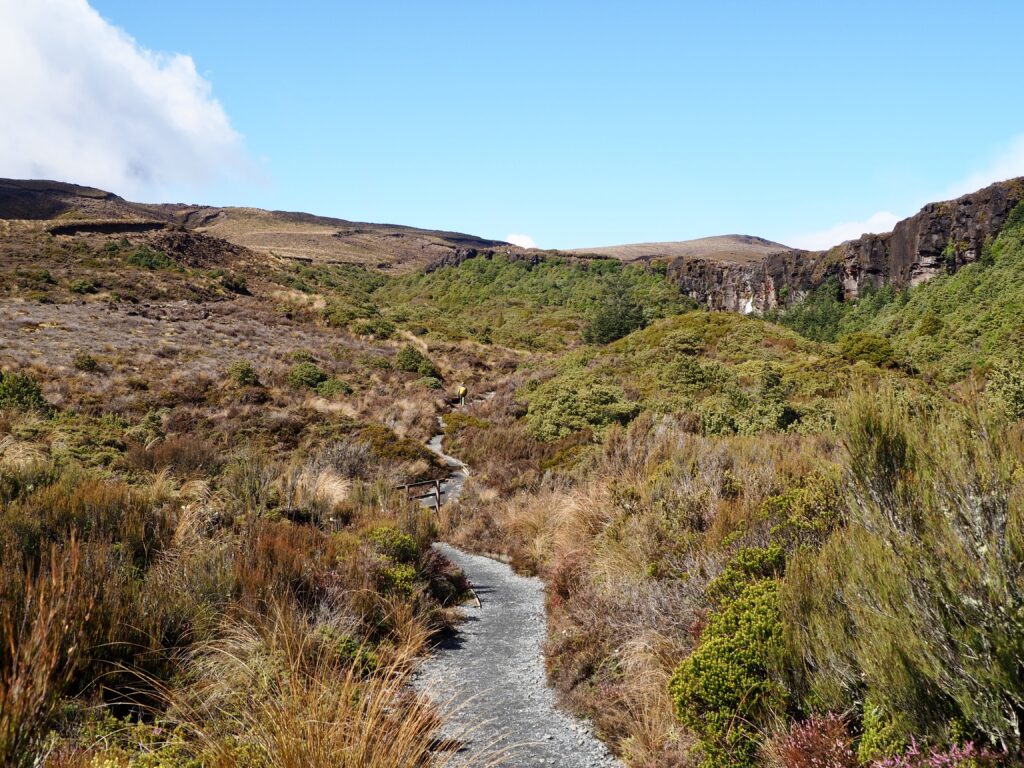






Ridge Track
It was still early afternoon after that hike, so I had time to explore the park a little more. I picked the Ridge Track next, since it has some more elevation gain, in hopes of more spectacular mountain views. The track is an out-and-back which takes about an hour in total. The first half was under tree cover, before emerging onto the open mountainside. The end of the trail is rather abrupt too, halting suddenly halfway up the slope with a viewing platform. It had gotten overcast and drizzly again when I left the forest, which obstructed the views somewhat.
Also, surprisingly, the mountains were not the main view! I could see them to either side of me, but the trail’s hillside still blocks them, since you don’t get to the top. Instead, the main view was behind me. From the platform, you can look down from where you came, into the valley where the visitor centre sits. It’s a wide, sweeping view, but the weather made it all a bit misty and hazy. While not a bad hike at all, it wasn’t quite what I expected.
Back at the bottom, I popped into the visitor centre to escape the rain. They have lots of exhibits inside, about the area’s geology and wildlife. I spent at least half an hour reading everything, so it’s worth stopping in! Then, I hopped back in the car to resume my drive. Continuing around the western border of the park, I had to keep my eyes on the road to not get distracted by the stunning mountain views. Then, once Tongariro disappeared from sight, I reached Lake Taupō, driving all the way up its eastern shore. I stopped a few times to enjoy the views, before eventually arriving in Taupō by early evening.






Day Two – Taupō
My hotel was very central, so it was easy to get around town on foot. There were plenty of restaurants and the lakeshore was just a few minutes away. I was also delighted to get a room facing towards the lake and I could see all the way across to Mt Ngauruhoe on the far side! Lake Taupō is actually the crater of an ancient, dormant supervolcano. It last erupted about a thousand years ago and Chinese writings from the time report grey skies of ash! It’s truly staggering how massive the supervolcano is… Fortunately, everything is calm for now and the lake is vast, serene stretch of blue in the centre of the North Island.
Lake Taupō Cruise
I was headed out onto the water this morning, walking from my hotel to the harbour on the Waikato River. There are several boat tour companies but I chose Sail Barbary as they use a smaller sailing yacht with an electric battery, so more environmentally-friendly than the diesel vessels. And much quieter! We used the battery while sailing down the lake, but were able to rely more on the wind for the return journey. It’s several degrees colder on the water than on shore, so be sure to wrap up warm! There were hot drinks and blanket-like ponchos available in the cabin though.
Much of the trip was a quiet, serene cruise on the water, but we did have a destination. The Māori rock carvings are a well-known attraction that most of the cruises take you too. Traditional Māori carvings are done on wood, but an artist found this flat rock face in the 1970s and decided to carve the stone with more modern tools. The main design is the face of Ngatoroirangi, the Māori navigator who brought settlers to this area. The surrounding rocks have smaller designs too though, so don’t overlook them!
The water was a bit choppy round here, so it was tricky for the skipper to keep us in place, but he got us as close as possible for as long as he could to observe all the details. And there are plenty of them! I was so impressed with how someone achieved this design in such a tricky location. You can only see the carving from the water too, as it faces away from the land. It might have been a nicer activity for a summer’s day, when it’s warm enough to swim too, but I was still glad I did it.





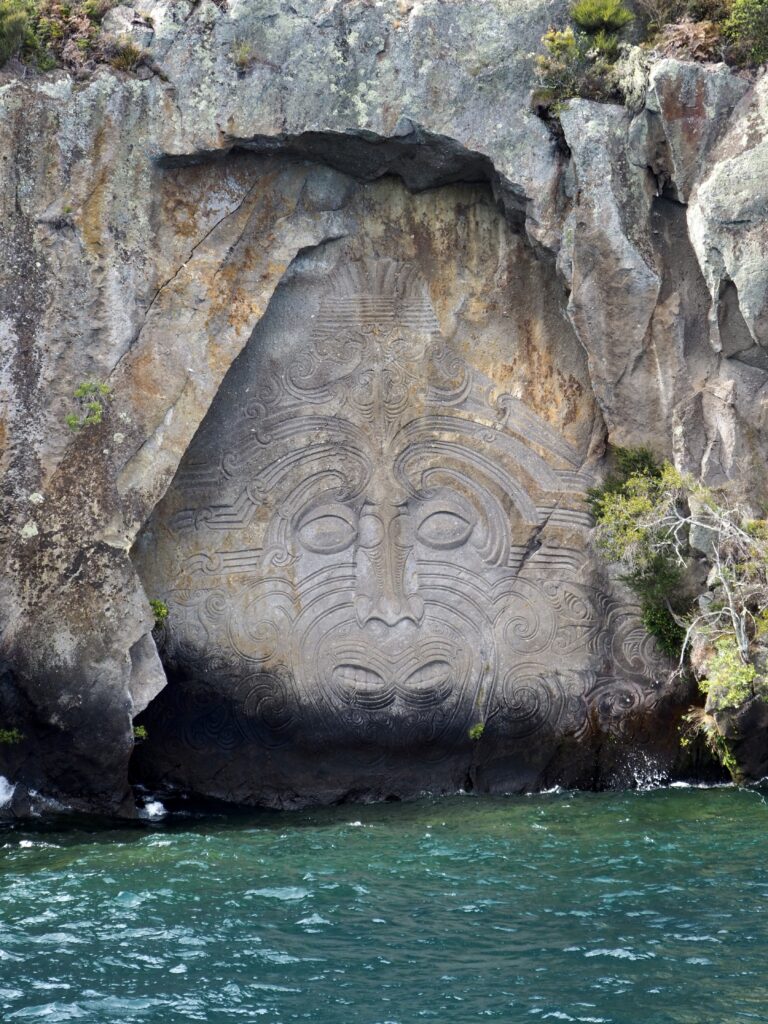
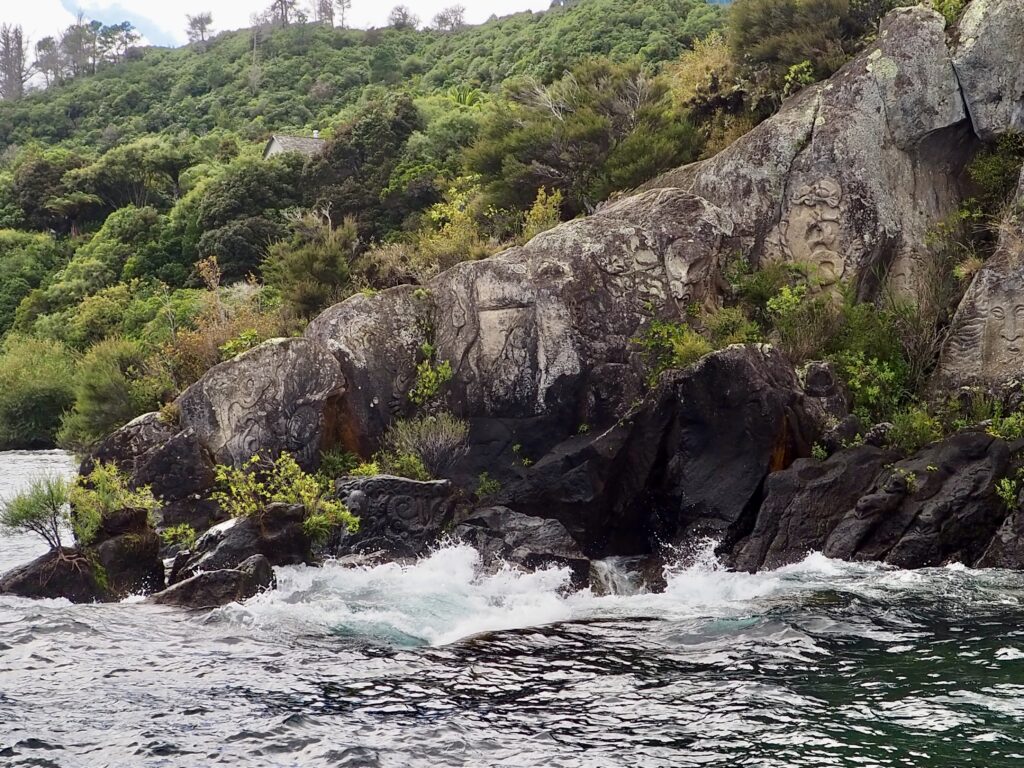
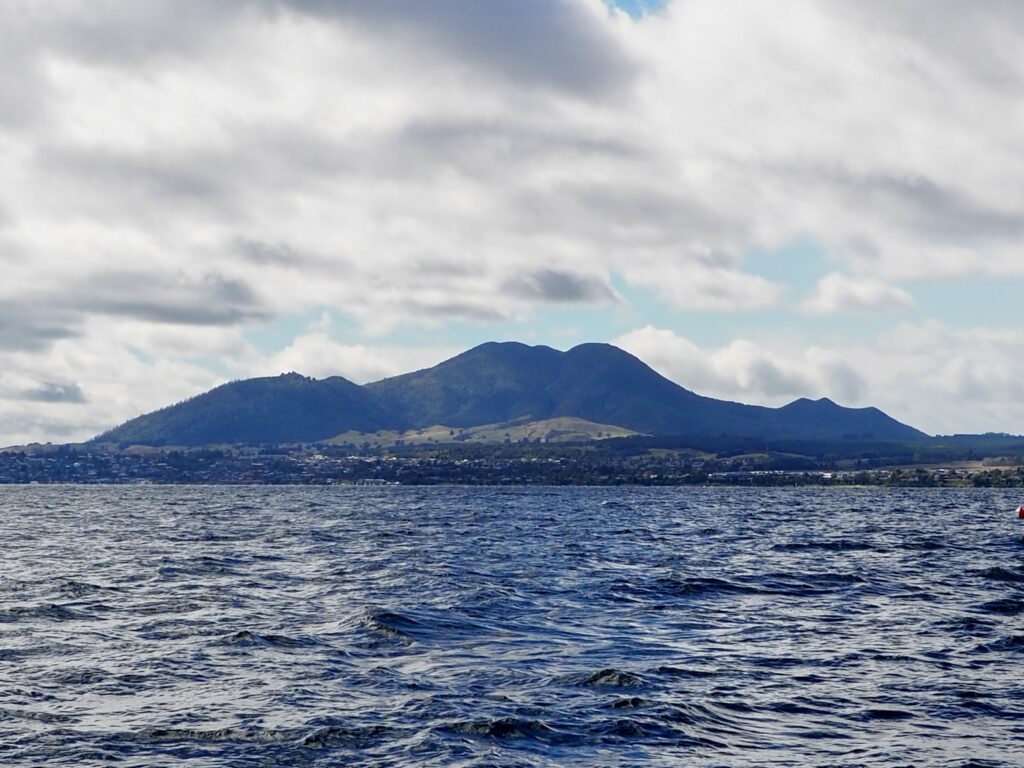
Orakei Korako Geothermal Park
Back on land, my next activity took me out of Taupō and a short drive north. This part of the country is full of geothermal features, as I’d already seen with the volcanoes in Tongariro and the crater that is Lake Taupō. I was off to find even more though with a visit to Orakei Korako, a geothermal park. It’s out in the countryside, so you really need a car to reach it. The park is actually across the river, only accessible via the quick boat journey included in the ticket. Then, I spent the next couple of hours roaming the boardwalk path on a self-guided journey through an astonishing geothermal landscape. You can see part of the park from the river, but there’s actually far more to it, as the boardwalks guide you through the surrounding bush.
There are plenty of information boards around to explain what you’re looking at and how these features are formed. I think I was mostly just gawking at such unique sights! There were geysers and mud pools and steam gushing up out of the ground. Wide, flat silica terraces painted in a rainbow of colour from the algae growing in the hot water. And the large Ruatapu Cave, with a pool at the bottom, which is one of only two geothermal caves in the world, a pretty cool statistic! The faint smell of sulphur lingered in the air, but it wasn’t overpowering enough to make me feel unwell or anything. It was almost like a strange, otherworldly, alien landscape. Yet it’s all naturally formed by our own Earth and evidence for just how powerful and diverse Mother Nature can be. It’s a beautiful, fascinating place to explore!








Wairakei Terraces Thermal Spa
While the geothermal sites are stunning to look at, no long weekend in Taupō would be complete without a soak in the thermal waters! Wairakei Terraces had popped up on some NZ Instagram accounts I started following and it’s an adults-only spa, so I was hoping it would be a peaceful option. There were certainly no loud kids around, but since it was a public holiday weekend, it was pretty busy. I arrived in the late afternoon, maybe around 4pm, and I’m glad I didn’t go any later (it’s open until around 9pm I think). It only got more full as time went on and the queue at the entrance was pretty long when I left.
Anyways, the spa has four silica pools (two are connected under a bridge though) full of blue-green mineral-rich water. Each pool is a different temperature, getting warmer as you head up the hill. All of them are hot though, no cooler/temperate option like the Mount Hot Pools back in Tauranga. I didn’t last very long in the hottest one! But I did spend about an hour there in total, swapping between the pools and drinking plenty of water inbetween. There’s also a walk along the geothermal terrace, but this requires an extra ticket payment, which I opted to skip. The pools are surrounded by leafy green foliage too, creating a tropical jungle vibe. Less busy would have been nice, but I still enjoyed my visit regardless!



Day Three – Rotorua
Waimangu Volcanic Valley
The third day of my long weekend in Taupō took me out of town again and a little further north to Rotorua. It’s about halfway between Taupō and Tauranga, so easy to reach from either. My first stop, however, was a little ways before Rotorua. Turning off the main highway, I headed for the Waimangu Volcanic Valley, another Instagram discovery actually. This advertises itself as the youngest geothermal site in New Zealand, since the Mount Tarawera eruption that created it only occurred in 1866. Which is pretty crazy to think about!
I chose the full ticket, which includes the boat cruise and the self-guided valley walk. The timings work so that you walk the valley first, which takes about 1.5 hours, arriving at the lake in time for your cruise. Then have the option of walking or taking the bus back. I was one of the first people to arrive that morning to a near-empty car park – by the time I left, it was overflowing, with cars parked out on the roadside! It also meant I got a pretty peaceful valley walk with only a few other people around.
The geothermal sites range from huge crater lakes with steam rolling off their surfaces, to bubbling mud pools and hot streams full of colourful algae. Frying Pan Lake has the largest surface area of any hot water spring in the world. And Inferno Lake is found inside a steep-walled crater. I also enjoyed seeing pūkeko picking their way across one of the terraces! All set in a lush, green valley and I was fortunate to have sunny, blue skies! It was all very scenic and beautiful, and so fascinating to learn about all the features.





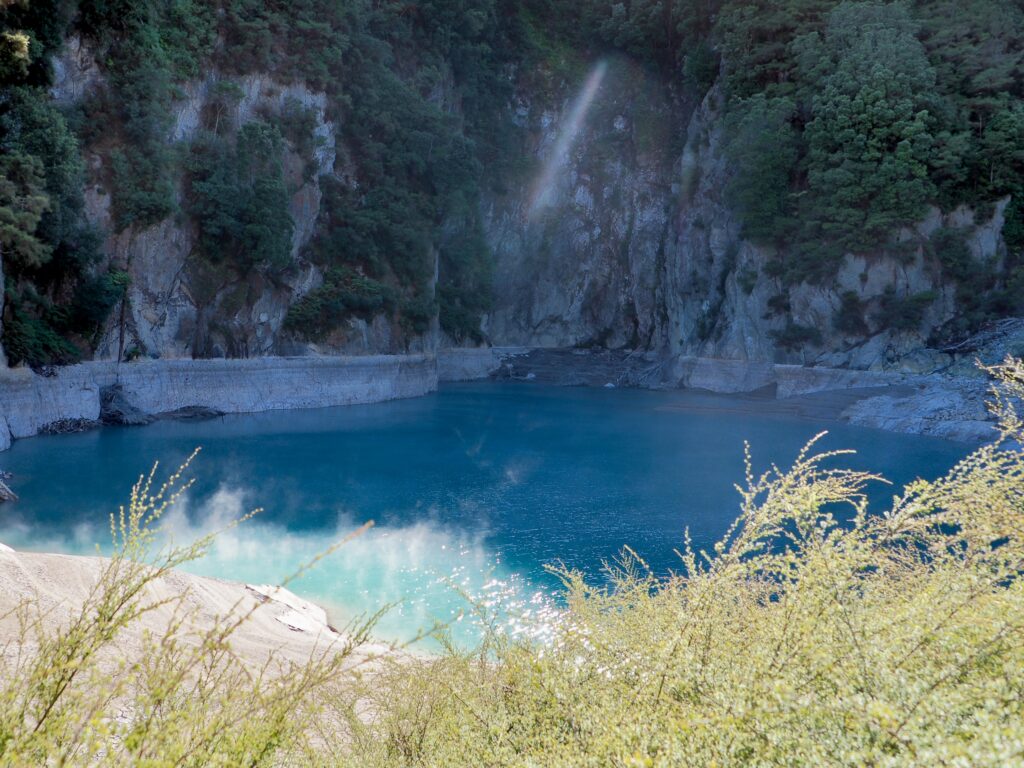




Lake Rotomahana Cruise
The Lake Rotomahana cruise lasts about 45 minutes, circling the lake under the watch of Mount Tarawera. The lake was formed after its eruption and used to be the site of the world-famous Pink and White Terraces, which are now buried under its surface. It’s a shame they’re gone, but a reminder of how powerful and volatile volcanic activity can be! The lake’s shores are dotted with steaming vents in the rocks. We also got to see one of the geysers erupt, thanks to the skipper’s careful timing. It can be hit or miss if you get to see one at any geothermal site, so I was glad to be able to tick it off! The water came hurtling up from the ground, reaching impressive heights.
I think I might have preferred the walk over the cruise, because of the diversity of the geothermal features along the valley. Just if you were trying to pick between one or the other! But it’s certainly worthwhile doing both. I caught the bus back to the entrance and stopped for lunch at the cafe there. Then I drove on to Rotorua proper.





Whakarewarewa Redwoods Forest
My next stop was actually nothing to do with geothermal activity! I’d happened to notice that Rotorua has a Redwoods forest on its outskirts. Since I didn’t make it to the Redwoods National Park when I was in California (although the Yosemite sequoias made up for it!), I thought this would be a nice addition to my trip. And it’s free! There is a treetop walkway you can pay to go up, but I skipped that. Instead, I chose one of the mid-length walking trails through the forest, which took me in a large loop.
Although it was fairly busy for Easter weekend, my walk was still pretty peaceful for the most part. Especially the second half, when I was off the most popular trail. The redwoods towered overhead, as I craned my neck skywards constantly to gaze up at them. They ranged in age too, from thick, old trunks, to narrower, younger specimens. Although not a native species, the redwoods were planted here over a century ago and are an important local recreational spot and part of the forest is designated as a Memorial Grove. There are many ferns and other native species interspersed too! It was a very pretty place to explore for an hour or so.




Polynesian Spa
Heading into Rotorua itself, my final destination today was another set of geothermal hot pools. The Polynesian Spa is built on the shores of Lake Rotorua, another volcanic caldera. It’s a sulphuric lake and actually very shallow, averaging about 10m depth. I had chosen the adults-only Pavilion Pools ticket, which offers views out across the lake. The blue of the water plus the design of the spa was all very pretty!
The Pavilion Pools are man-made, with the thermal waters pumped in. There are eight pools in total, most for sitting/bathing and then one larger one that you can stand up with the water up to your shoulders (depending on your height). Three are acidic, which is meant to be good for aches and pains, and the rest are alkaline, which is good for the skin. There’s also a reflexology walking path overlooking the lake, which I tried once.
I spent my time alternating between acidic and alkaline pools, taking breaks between. There’s also a cold shower available, which was great for a quick refresh and cool down! The pools are a range of temperatures as well, although I tended to pick whichever one looked least busy when selecting my next. Like yesterday, it got busier over time, so I was glad I went around mid-afternoon and stayed for about an hour and a half. Plus, I still had to drive back to Taupō for the night!



Day Four – Taupō
Spa Thermal Park
For the final day of my long weekend in Taupō, I really only had a half-day in town, before driving back to Wellington this afternoon. With so much driving ahead of me, I stretched my legs this morning instead, with a long walk from my hotel all the way up through Spa Thermal Park to Huka Falls and back again. Spa Thermal Park is an outdoor, public park, a large green space to the north of the town centre, away from the lake. The Waikato River flows through it, dazzling turquoise blue, and the walkway follows alongside it, undulating up and down along the way.
About halfway through the park, I came to Otumuheke Stream, a natural hot spring that joins the larger river. The stream is entirely natural, no built-up complex containing it, and therefore totally free to swim in. A few people were there when I passed, sitting under the tiny waterfall or lounging in the small pools above it. I was tempted by a dip, but with the afternoon drive ahead of me, I didn’t want to have to deal with changing or feeling like I wanted a shower after. I’d done my fair share of thermal soaks this weekend already!
Huka Falls
From the hotel, it took me close to an hour and a half to reach Huka Falls. I had just assumed this was another waterfall, of which I’ve seen several in New Zealand. But it was actually far more impressive than I’d imagined! Before reaching the actual falls, the Waikato River hurtles along a narrow canyon. The bright blue water is streaked with white foam as it rushes past in a furious frenzy and astonishing speed! I stepped onto the bridge to watch from above, before continuing along the last section of the walk, marvelling at the ferocity of water!
Huka Falls itself is an onslaught of white foam, a massive spray of it jettisoning from the end of the canyon. It’s not a high waterfall, but the power and force it has is incredible! The plunge pool is just more white foam all over the water’s surface, broken up by the jet boats that bring tourists up close. I was quite content looking from above though! Once I’d had my fill of the view, I retraced my walk all the way back through the park. Then it was time for one last look at the view of Lake Taupō and the mountains beyond, before driving all the way around its shores, past the east side of Tongariro National Park this time, and onwards south again.






Taihape
I did make one more stop worth mentioning on my drive back! Firstly, because I was not driving 4.5 hours without a break. But secondly, to see the town where my brother lived for his annual summer season this year. Taihape isn’t a big town, nor is there all that much to see there, so I wouldn’t have been making a drive to see it specifically. But it’s conveniently about halfway between Taupō and Wellington, so this seemed like the best time. I stretched my legs with a walk up and down its high street, stopping to pick up a snack.
The main attraction I was looking for, however, is the Gumboot Statue! I actually drove past it on the way into town, before parking and walking back again. It’s exactly what it sounds like – a large statue of a gumboot (or a welly boot to Brits like me), decked out in a rainbow of colours. Taihape calls itself the “Gumboot Capital of the World”, with a large farming community in the area, and thanks to a comedy sketch featuring a fictional, stereotypical Kiwi farmer from the town many years ago. They even have a Gumboot Day festival each year! I snapped some photos of the statue, as well as some sheep murals on an agricultural shop nearby, before continuing my long drive south.
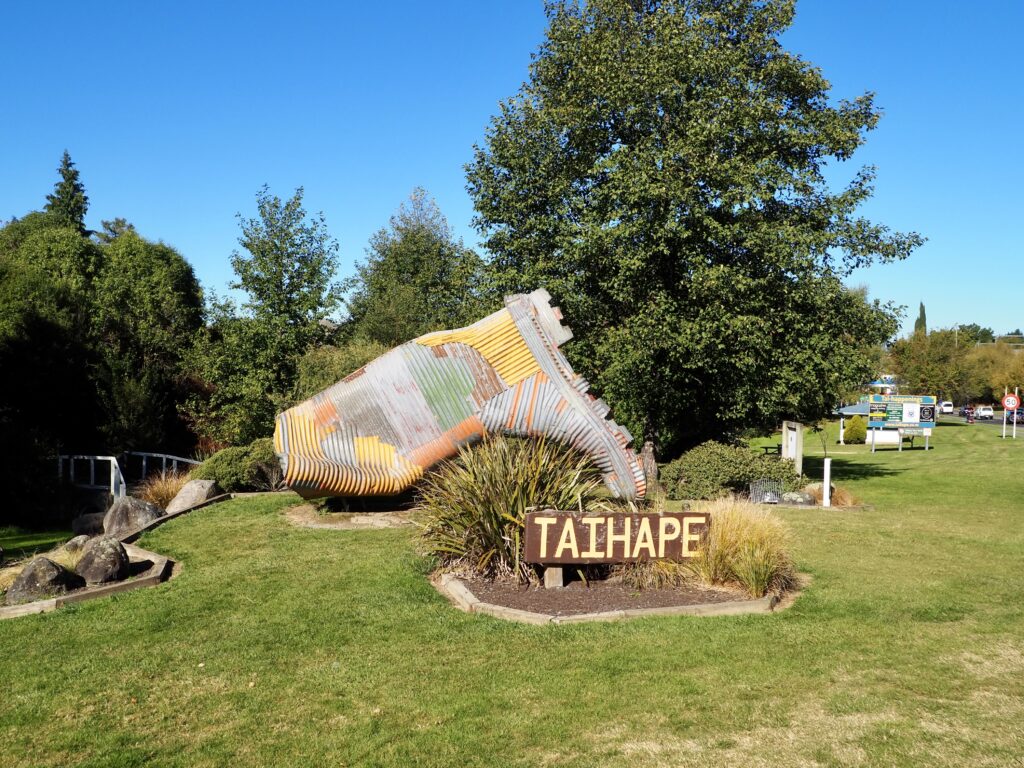


Long Weekend in Taupō
I really enjoyed this trip and would definitely recommend a long weekend in Taupō or including it as a stop on a longer New Zealand trip. I love exploring nature, particularly features that are unique or less common, so the geothermal sites are right up my alley! As long as nothing erupts anytime soon, of course. From the vast caldera that is Lake Taupō to the geysers and silica terraces, and of course, all the thermal waters to soak in, there was such a variety to see. And of course, we can’t forget Tongariro National Park, with its breathtaking volcanoes capped with snow. Taupō and Rotorua are definitely up there as contenders for my favourite place on the North Island so far!

Long Weekend in Tauranga
You May Also Like

Mekong River | Laos Traveller
20 August 2016
The Hong Kong Story | Museum of History
20 April 2016